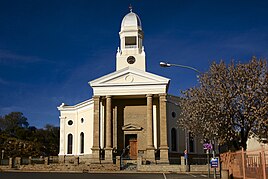This article needs additional citations for verification. (February 2012) |
Colesberg is a town with 17,354 inhabitants in the Northern Cape province of South Africa, located on the main N1 road from Cape Town to Johannesburg.
Colesberg
Koolsberg in Afrikaans orthography | |
|---|---|
Top:Dutch Reformed Church, middle left: Coniston House, right: Main Street, bottom left: Horse and Mill, right: Kemper Museum. | |
| Coordinates: 30°43′00″S 25°06′00″E / 30.71667°S 25.10000°E | |
| Country | South Africa |
| Province | Northern Cape |
| District | Pixley ka Seme |
| Municipality | Umsobomvu |
| Established | 1830[1] |
| Area | |
• Total | 174.84 km2 (67.51 sq mi) |
| Population (2011)[2] | |
• Total | 16,869 |
| • Density | 96/km2 (250/sq mi) |
| Racial makeup (2011) | |
| • Black African | 67.4% |
| • Coloured | 25.7% |
| • Indian/Asian | 0.6% |
| • White | 5.3% |
| • Other | 1.0% |
| First languages (2011) | |
| • Xhosa | 59.5% |
| • Afrikaans | 33.1% |
| • Sotho | 2.8% |
| • English | 1.8% |
| • Other | 2.9% |
| Time zone | UTC+2 (SAST) |
| Postal code (street) | 9795 |
| PO box | 9795 |
| Area code | 051 |
In a sheep-farming area spread over half-a-million hectares, greater Colesberg breeds many of the country's top merinos. It is also renowned for producing high-quality racehorses and many stud farms, including one owned by renowned golfer, Gary Player, are nearby.
History
editFounded in 1830 on an abandoned station of the London Missionary Society, and initially named Toverberg after a nearby hill, it was renamed Colesberg after Sir Galbraith Lowry Cole, then Governor of the Cape Colony.[3] The site of the town lay on one of the well-travelled routes used by traders, hunters and explorers to gain access to the interior. Towerberg or Coleskop is a prominent hill near the town and a landmark easily seen from a distance by travellers.
Colesberg saw a large number of battles and skirmishes during the second Anglo-Boer War, and the Colesberg Garden of Remembrance is located just outside the town.
A number of 1820 Settlers established farms in the Colesberg district. Outnumbered as a religious group, some attended the Methodist Church and others the Dutch Reformed Church, where services in English were specially held for them. Anglican officials in Cape Town appointed Dr CEH Orpen as rector and the first services were conducted in the Court House and the London Mission Chapel, which became known as St Stephen's Church. In 1852 the construction of the Anglican Christ Church was started, having been designed by Sophy Gray, wife of the Cape Town bishop Robert Gray.
The Colesberg Bank was founded in 1861.[4] Michael Davitt wrote while documenting the Second Boer War, that the previous generation noted the village as a rendezvous for hunters and diamond miners.[5]
Past residents
edit- Hennie Bingle, rector of the PUK
- General Piet Cronje, a South African general in both the Anglo-Boer wars.
- Danie du Plessis, Head of the South African Railways & co-founder of The Afrikaner Broederbond
- Frans du Toit, a South African Economist, and Trade Commissioner.
- Ricardo Loubscher, South Africa national rugby union team player & rugby coach
- Zamani Saul, Premier of the Northern Cape
- Nicolaas Theunissen, South African Test cricketer
- Nombulelo Lilian Hermans (Former ANC regional treasurer and regional deputy chairperson, Member of the National Assembly of South Africa)
Cityscape
editArchitecture
editThe town boasts many buildings that were built in a blend of Cape Dutch and Georgian architecture with ceilings of reed, and yellowwood timbers, and others that display a range of designs reflecting the changes of 19th century building. Originally plots were pegged out and sold on the site of the town to fund the building of the Dutch Reformed church.
Society and culture
editMuseums, monuments and memorials
editA large number of Heritage Sites registered with the South African Heritage Resources Agency are located in Colesberg.
Economy
editFarming in the area is dedicated almost entirely to horses and merino sheep. While in a sheep-farming area spread over half-a-million hectares, greater Colesberg breeds many of the country's top merinos. Colesberg is renowned for producing high-quality racehorses and many stud farms, including one owned by legendary golfer, Gary Player, are nearby. The ostrich-feather boom of the early 1900s, which left many farmers rich, is long forgotten.
The town has a thriving tourism industry, in part because it represents a rough halfway point between Johannesburg and Cape Town.[6] There is a hotel, a motel, and many guest houses and B&Bs around town, most having restaurants and pubs on-site. Several guest farms operate in the district offering accommodation with 4x4 trails, mountain bike trails, game hunting (mainly springbok, wildebeest and blesbok) and bird watching. Three major service stations with on-site shops, restaurants and toilet facilities are located on the N1 at Colesberg. Small industries are located in town, including a sheep abattoir, a factory which makes a range of furniture to order and a panel beater.
The Doornkloof Nature Reserve is located near Colesberg on the confluence of the Orange and Seekoei Rivers.
See also
editReferences
edit- ^ Robson, Linda Gillian (2011). "Annexure A" (PDF). The Royal Engineers and settlement planning in the Cape Colony 1806–1872: Approach, methodology and impact (PhD thesis). University of Pretoria. pp. xlv–lii. hdl:2263/26503.
- ^ a b c d "Main Place Colesberg". Census 2011.
- ^ Raper, R.E. Dictionary of Southern African Place Names. Human Science Research Council. p. 119.
- ^ The Standard Bank of South Africa Limited. "Standard Bank Group – Historical Overview" (PDF). p. 2.[permanent dead link]
- ^ Davitt, Michael (1902). The Boer Fight for Freedom. The University of Michigan: Funk & Wagnalls. pp. 357.
- ^ Krige, Nadia. "South Africa's Halfway Towns". Traveller24. News24. Retrieved 29 January 2020.







